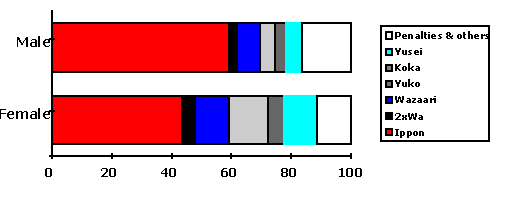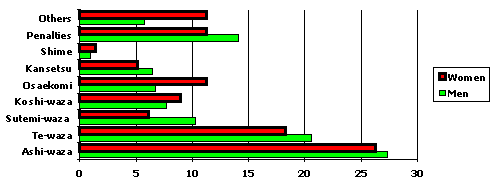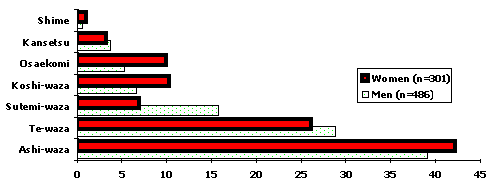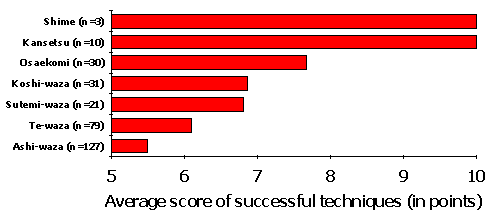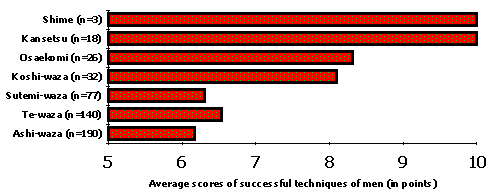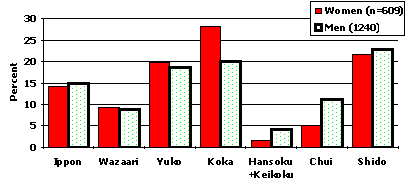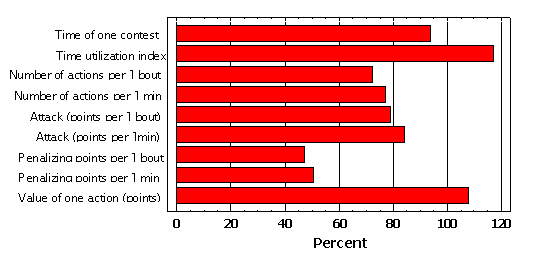Dr Stanislaw Sterkowicz, DIFFERENCES IN THE SCHOOLING TENDENCIES OF MEN AND WOMEN PRACTICING JUDO (BASED ON THE ANALYSIS OF THE JUDO BOUTS DURING THE 1996 OLYMPIC GAMES)INTRODUCTIONStudies on participation in sporting events are indispensable to prepare male and female contestants so that they could solve the problems resulting from sports fighting. As early as the Tokyo Olympic Games in 1964, Doi taped successful technical elements (Doi 1971). The experts from Judo Kodokan Institute also analyzed video materials from competitions (Matsumoto et al. 1978). Somewhat similar studies were conducted in Poland by means of notation charts: (Adam (1984), Jaskolski, Andryszczyk (1979), Sikorski (1971,1985), and by the computer analysis, Franecki et al. (1983). Research on women participation in judo competition was first undertaken in the Department of Combat Sports at the Academy of Physical Education in Cracow (Sterkowicz, Kesek (1983). All the efforts by practicians and theoreticians of the sport helped to perfect the combat recording method on notation charts. Hamana et al. (1994) concentrated on the developing of the ways to record the course of judo bouts. Fast data computer processing was possible during the Seoul Olympic Games in 1988 (Baranowski 1989). The aim of this paper, which is a follow up of the studies conducted on the materials gathered on the Barcelona Olympic Games (Sterkowicz, Kiejda 1994) is to answer some still topical questions involving the differences and similarities in men’s and women’s participation in judo competitions: 1. Manner of winning The results of this comparison will require some interpretation in the light of the available literature concerning the body build, physical fitness features and psychic preparation of the female competitors which determine their possible differences with reference to the male competitors. THE MATERIAL AND METHODThe documents made available by the organizers of the Atlanta Olympic Games (Atlanta 1996, Official 1996) constituted the material for this study. 151 female and 241 male judoka entered for the Olympic Judo Tournament (Atlanta 1996). 213 bouts between the female contestants and 314 bouts between the male contestants were analyzed in the respective 7 weight categories. The frequency of manner of winning was compared: Ippon, 2xWaza-ari, Yuko, Koka, Yusei-gachi and others. The structural analysis of each bout also included the type and frequency of successful attacks employed in the standing position and during ground work, taking account of the Kodokan classification. These fighting techniques were illustrated with pictures found in publications (Pawluk 1973,1975, Lehman, Muller-Deck 1987). Then the parameters characterizing the sporting struggles at the Twenty-sixth Olympic Games were juxtaposed: the average time of fight, the number of techniques awarded with points, the number of points (scored) for successful actions in one fight, the number of penalty points in one bout, the average score of techniques awarded with points. Considering the fact that fights can terminate before the regular time, an index was introduced to show a ratio of the actual time of all the fights in a given tournament to theoretically maximum time of all the fights (Sikorski 1985): Sactualtime/Smaxtime 100 Some statistical methods were used to compare the data from the studied Olympic Games of 1996. THE RESEARCH RESULTS AND DISCUSSIONA) The Age and the Manner of Winning of Male and Female Contestants The women were, on average, younger by one year than the men. The female judoka’s weighted mean age was 24.4, while that of the male judoka’s was 25.5 yr. On the basis of the figures released by the International Judo Federation (Atlanta 1996) for every category, it was discovered that the youngest female contestant (16.4 yr.) fought in the 48 kg category, while the oldest one (34.8 yr.) fought in the category over 72 kilograms. The youngest male judoist (18.9 yr.) fought in the 71 kg category, while the oldest male contestant (40.5 yr.) fought in the category over 95 kg. The mean arithmetic in the women’s weight categories ranged from 23.5 yr. (below 48 kg) to 25,9 yr. (above 72 kg), while in men’s weight categories it ranged from 24.5 yr. (below 78 kg) to 26.9 yr. (above 95 kg). Consequently, the oldest contestants fought in the heaviest weight categories, i.e. the women (above 72 kg) and the men (above 95 kg). The manner of winning depended on the sex of persons participating in the Olympic Judo Tournament (X2 = 26.90; df = 6; p. < 0.001). The strength of this dependence was significant because the ratio of contingency coefficient (standardized on its possible maximum) was C = 0.27 (Table 1). Tab.1. Manner of declaring winners in men’s and women’s bouts during the Atlanta Olympic Judo Tournament (1996)
The diversification between the men’s and women’s participation in the contests can be explained in the light of the findings concerning sexual dimorphism in sport, as female competitors respond to the same training stimuli differently from male contestants. The studies of Bale (1983) and Stepnicka (1972) showed that the higher level of training and competitions reduced sexual dimorphism in an insignificant way in the same sporting events. Carter and Heath (1990) stated that the somatotype provides total information which is more useful than calculating particular measurements from predicting equations. Claessens (1984) discovered increased values of endomorphy and mesomorphy with low levels values of ectomorphy. The female contestants of this sport were more endomorphic and less mesomorphic than the male competitors, but the levels of ectomorphy were the same between the females and males. Taking into account the levels of tissue components in the men (Brief 1986) it was calculated that the levels of endomorphy, mesomorphy and ectomorphy in the female contestants amounted to 158%, 68% and 129% respectively. It is assumed that people with the prevalence of endomesomorphy in their body build achieve the best results in their tests on strength and power. Undoubtedly, those actions leading to the end of a judo bout before time required maximal power (see table 1.). The number of Ippon grades in the list of the manner of winning is striking in both groups of the men and the women. While it reflects the perfection of attack, it shows the drawbacks in defense. These findings were borne out in the materials from the Barcelona Olympic Games (Smaruj, Drabik 1996), Sterkowicz 1994) and in a surprisingly increased efficiency of throws executed by the women after disturbing their opponents’ balance to the left. An element of surprise may have played some part (Smaruj, Drabik 1996). The comparison of the structural indices (percentages) in the groups of the men and women competing in Atlanta showed considerable differences in three out of the seven ways of winning. The differences occurring in the structure of the winning manner achieved by the male and female competitors are illustrated in figure 1.
Fig.1. Method of winning of the fights in the Olympic Judo (Atlanta’96) Significantly greater frequency of Ippon grades was characteristic of the men, which terminated bouts before time (p < 0.001). The women, on the other hand , more often won their contests because they secured a five point lead over their opponents (Yuko) (p < 0.001) and because of the referees’ decisions due to the lack of evident superiority, Yusei (frequency differences were significant at p < 0.05). Seoi-nage throws played a decisive part in the case of the women (women 11.3%, men 10.6%). Penalty points were given for fight evasion (6.6% in women and 9.0% in men) pretended attacks (1.9% and 2.9% respectively), stepping outside the mat area (1.4% and 0.3%), defensive style (1.4% and 1%) and so on. Thanks to the successful locks on the elbow Ude-hishigi-juji-gatame the female competitors won before the period in 5.2% and the men in 6.4% of bouts out of the total number of bouts of the group, which were recorded for the purpose of comparison. The Nage-waza lead to victories in Atlanta both in the case of women and men (59.6% and 65.9% respectively). The second decisive factor in victory were penalties (27.7% and 22.2%) while the third important techniques were holds in groundwork – Katame-waza. It was observed that only that only throws Harai-goshi (5.2%) and holds Tate-shiho-gatame (2.4%) noticeably more often (p < 0.05) determined victories in the case of the female than male contestants (2.2% and 0.3% respectively). In order to show the importance of particular groups of techniques in the referee’s final decisions on the victory in the bout a list was prepared taking into account nine effective actions (fig. 2).
Fig. 2. Percent of successful actions in female judo contestants’ bouts (n = 213) and in male judo contestants’ bouts (n = 314) There was a great similarity between the groups of men and women in the number of actions that were decisive in victory. Regardless of the sex, the techniques of throws Ashi-waza and Te-waza were most frequent while strangulation techniques Shime-waza were most rare.. The more precise analysis of structural indices additionally revealed some differences in group schooling profiles. Some applied Sutemi-waza throws involving a fall of the attacking contestants (p < 0.05) lead to victory more frequently in the case of the male rather than in female judoists who preferred holds in groundwork (p < 0.05). It seems that the weaker shoulder strength in the women was partly responsible. Biomechanical studies show (Obuchowicz-Fidelus et al. 1985, Sikorski 1985) that the ratio of the sum of muscle force moments and the body mass in the leading female competitors was 68% of those discovered in the male contestants. The greatest differences in this respect occurred during measurements taken on the shoulder joint in the case of which the above – mentioned ratio was 57%. The knee joint however was characterized by the highest ratio values where the women achieved 93% of the values measured in the male judoists. One should bear also in mind that the favorite hand and foot offensive technique was connected with specific body build proportions (Kuzmicki 1981, Marchocka et al. 1984) and their muscle strength topography (Dabrowski et al. 1986). During the Seoi-nage and Tai-otoshi hand throws the women reached the maximum force equal to only 61% of the that of the men. Their dynamic force motion speed and kinetic energy was lower as well (Haga et al. 1984). Probably the greatest disproportion between the amounts of muscle force moments in the shoulder joint was the weakest link in the kinematics chain, which rendered some fighting techniques for the contestants difficult to apply. From the practical point of view, these indices of the contestant’s preparation which are open to the training influence are of great importance. So it seems necessary to mention the fact that in the case of women the stimulation of the mechanism of non lactic acid and anaerobic energy process resulted in a 13-31% increase in MAP (21.1% on average) within one year. Consequently, an improvement in sporting results was observed in the female judoists under research (Yanagisawa et al. 1994). B) The Range of Technical Schooling of the Men and Female Judoists 1849 actions with awarded points in all were recorded during the Olympic Judo Tournament in Atlanta. When all the attention was focused on individual groups of techniques which were rewarded with points by the referees during the judo bouts (fig. 3), some essential dependencies in frequency distribution on the sex (X2 = 21.82; df = 6; p. <0.001; C = 0.20) were revealed.
Fig. 3. Frequency of successful combat techniques during Atlanta Olympic Judo Tournaments (in %) When the women’s participation in judo contest was viewed from this angle it was verified that they not only less frequently executed sacrifice throws (with a fall) and more often used holding techniques on the ground, but also important was the frequent application of the hip and loin throws Koshi-waza (p. < 0.01) and strangulation techniques (p. < 0.05). So the hypothesis resulting from the analysis carried out on the material from All-Polish Judo Competitions was this verified (Sterkowicz, Kesek 1990). Strangulation belongs to the techniques in the case of which, like locks Kansetsu-waza, there are no gradation in the awarded points; a successfully applied technical element being rewarded solely by Ippon = 10 points. The average value score for attack by holds on the ground was lower in the case of women than men. A similar relation was characteristic of the hip throws, rewarded with fewer points in the case of the female judoists, both hand and leg throws on the next place of importance (fig. 4). In the case of the male contestants, however, offensive hand throws were more important than the sacrifice throws Sutemi-waza. (fig. 5).
Fig. 4. Number and average score of successful combat techniques in the Olympic Women Judo Tournament (Atlanta 1996)
Fig. 5. Number and average score of successful combat techniques in the Olympic Men Judo Tournament (Atlanta 1996) With the ranking series for seven classifying groups of judo techniques which were formed according to their frequency and their average point value, a high correlation between them was found. The more frequently some fighting techniques were applied, the less valuable they were in the referees’ opinion. This relation was certain (Spearman rank coefficient Rsp = – 0.955; p. < 0.02) in the case of male contestants, while in the case of women this coefficient Rsp showed a considerable correlations (Rsp = – 0.833; p. < 0.05). Likewise in Barcelona (Sterkowicz 1994), 15 technical elements listed in table 2 contributed to the three fourths of the successful attacks (women 73.4%; men 69%) during the Olympic Games in Atlanta. The following techniques used by the female contestants proved to be the most effective: Seoi-nage, Kuchiki-taoshi, among the hand throws; O-uchi-gari, Uchi-mata, O-soto-gari, Ko-soto-gake, Ko-uchi-gari, and Ko-soto-gari predominated among the foot and leg techniques, Harai-goshi dominated among the loin techniques; and finally Tani-otoshi was the most frequent of all the Sutemi-waza. Three groups of holds were represented by Kesa, Yoko, and Tate alongside with the elbow joint locks – mainly Ude-hishigi-juji-gatame. Tab.2. Fifteen most successful technical elements used during the Olympic Men and Women Judo Tournament — Atlanta ’96 (figures and percentages)
*Different variants (Eri, Ippon, Morote);**Together with Kuzure; ***ex aequo with Sukui-nage (n = 6) In the case of the men, the hand techniques Kata-guruma, Sukui-nage were the most popular as well as the sacrifice throws Tomoe-nage, which replaced elements characteristic for the female judoists: Harai-goshi, Kesa-gatame, Tate-shiho-gatame. C) Elements of the Referee’s Evaluations, judo combat quantitative parameters Table 3 lists evaluation reflecting the scoring of the female (n = 609) and the male (n = 1240) judoists’ combat. Tab. 3. Scoring of men’s and women’s bouts during the Olympic Judo Tournament (Atlanta 1996)
This size distribution distinguished the female from the male judo contestants in a significant way (X2 = 36,03; df = 6; p. < 0.001; C = 0,17). Additionally, a test for two structure indices (percentages) was used to present the differences consisting in a peculiar prevalence of Koka grades (p. < 0.001) as well as the less frequent negative scores, i.e. statutory punishing points Keikoku (p. < 0.01) and Chui (p. < 0.001) in the case of women (fig. 6).
Fig. 6. Frequency of referees’ scoring during women’s and men’s bouts It follows from table 4 – representing parameters characterizing typical bout in the Olympic Judo Tournament – that the actual time of the women’s bouts was similar to that of men’s. The higher value of the time utilization percentage index in the case of the women judoists resulted from the rule limitations to maximum 4 minutes (5 minutes in the case of men). Tab. 4. Averaged quantitative and qualitative parameters characterizing combat during the Atlanta Olympic Men and Women Judo Tournament
In general there were fewer scored actions fewer attacks and punishing points in the women’s judo bouts. The average value of the scored actions exceeded of five points (Yuko) and it was slightly higher than in the case of the men. Additionally, the parameters defining the women’s judo fight in reference to the men were illustrated in percentages (fig. 7) in order to emphasize the sexual dimorphism.
Fig. 7. Characteristics of women’s combat in comparison with men’s judo combat (indices defining men’s combat equal 100%) The greatest differences (<80% in men) occurred in the number of penalty points and in the number of actions scored per one bout and per one minute of activities on the mat. As a result, the index of time utilization (actual fighting time) was far more higher, than in the case of the men 72.5 : 62.0% despite the slightly higher number of the actions rewarded with points in the case. This situation may have been influenced by the anaerobic exertion skills (Yanagisawa 1994) and the lower aggressiveness of women in combat, whose actions, as it was showed earlier, were less frequently awarded with penalty points. In a 30-second test on anaerobic endurance taken on a bicycle ergometer, the female contestants had significantly lower indices of maximal power, work performed and it took longer for them to achieve the maximal frequency of pedaling. When the body mass was taken into account, the index of maximum power in the case of women amounted to 84%, while their pedaling frequency reached 130% (which should be considered as a worse result) of the results achieved by the men (Zdanowicz and Wojczuk 1984). The common feature of judo fight are periods of continuos work with maximal or submaximal intensity divided by shorter or longer intervals (Kesek and Sterkowicz 1991, Sikorski 1985, Swiszczow 1990). The analysis of the relations between the time of effort and of break is important , because it allows the coaches to adjust their training methods (i.e. stimulate the development of the necessary stamina motor skills) to the requirements of tournament participation. The issues connected with time temporal structure of fight were solved by Swiszczow et al. (1990). The analysis of the tournament participation of the judo contestants at the Seoul Olympic Games allowed to distinguish between the actual fight periods and breaks that divided them. In the course of the actual fight the contestants attacked, defended themselves, countered their opponents’ attacks, broke their defense, or awaited their opponent’s attacks. The time of the time lasted 300 seconds, while the length of intervals (breaks) was not more than 150 seconds. That 300 second-fight was broken by the referee on the average eleven times, which produced twelve fragments. This temporal structure of the fight was most often observed (40% of total number of fights). There were also fights made up of from one to four sequences which ended prior the regular time, as well as bouts containing even eighteen fragments of continuous work. In a typical twelve-fragment fight the length of one sequence ranged from 15 to 30 seconds, while the length of the break was between 8 and 17 seconds. The number of actions evaluated in the course of one fragment of the bout was on average between 0.35 and 1.17. The greatest irregularity occurred in the last fragment which was characterized by the least successful actions. The findings above were partially born out by the materials gathered on the female contestants participating in the Barcelona Judo Tournament (1992) during which the number of attacks determining the highest score in the successive minutes of fight (1-4) increased from 0.118 to 0.157, while, in the case of the men, that number decreased from 0.158 to 0.104 between one and five minutes of the fight (Sterkowicz 1994). The underlying reasons that influence the choice of fighting techniques could be found among others in the motivations of the athletes in which some essential differences between male and female judoists could be found. The female contestants were to a lesser degree motivated by the aspiration for excellence and perfection in action, or the need for the stress experienced during the competitions as well as need for aggression. On the other hand, they evinced a greater sense of independence and aspirations for extrinsic success. CONCLUSIONSIn the light of the comparison made between the male and female judoists and their participation in the Atlanta Olympic Judo Tournament (1996) one can formulate the following remarks and draw some conclusions: 1) The ages of male and female judoists were similar, and on average they were about twenty-five years old, which can be regarded as most favorable to attain a high level of form in judo. 2) The manner of winning was indicative of the women’s inferiority in maximal anaerobic power in comparison with the men, which was borne out by fewer victories before time by Ippon achieved by the female judoists. In the case of the two groups the throwing techniques and the tactical skill of coercing the opponents into penalty points contributed to their victories. 3) There was a dependency between the contestants’ selection of means of fight and their sex. The essential difference was in the women women’s frequent use of the holding techniques (in groundwork). On the other hand, the male contestants made a successful use of risky throwing techniques involving falls of the attacking contestants. 4) There was some dependency between successful attack and their value in points. The more frequently a given type of attack was employed the fewer points were awarded by the referees, which indicated that adequate defensive techniques had been acquired to oppose the attacks. 5) The value of standard parameters defining the temporal structure of fight revealed the greatest differences in the frequency of penalty points which showed that the women belonged to the more rule-abiding group. The frequency of actions rewarded with points was higher in the case of the male contestants and, consequently, the fighting time utilization index was lower than in the case of the female contestants, whose participation in the tournament was characterized in general, by slightly less intensive fight. Although the essential difference in the rules of sports judo of women and men lies in the maximum time of their fights, it is difficult to explain the facts documented in this paper only by the above – mentioned difference. In the light of the presented general characteristics of the men’s and women’s participation in tournaments, one can distinguish between weight categories and individual characteristics of tournament contestants. The subjects calls for further research. It will be useful, therefore, to observe these very important factors: optimum age for maximum achievements in this sport, body build indices, physical and psychic preparation, which modify the behavior of the male and female contestants in particular weight categories. BIBLIOGRAPHICAL REFERENCES1. Adam M. 1984. Rejestracja i ocena techniczno-taktycznego przygotowania zawodników judo. Materialy szkoleniowe, PZ Judo, Warszawa. 2. Atlanta Olympic Games Statistics. 1996. http:/www.ijf.org/og96-094/l 3. Bale P. 1983. Somatotypes of Sportsmen and Sportswomen. Eastbourne. Brighton Polytechnic. 4. Baranowski T. 1989. Systemy komputerowe na Igrzyskach Olimpijskich w Seulu. Sport Wyczynowy, nr 1. 5. Brief J.F. 1986. Somatotipo y caracteristicas antropometricas de los atletas Bolivarianos Universidad Central. Venezuela, Caracas. 6. Carter J.E.L., Heath B.H. 1990. Somatotyping – development and applications. Cambridge Studies in Biological Antropology. Cambridge University Press. Cambridge – New York – Port Chester – Melbourne – Sydney. 7. Claessens A et. al. 1984. Body Structure, Somatotype, and motor Fitness of Top Class Belgian Judoists. Olympic Scientific Congress, Eugene, Oregon. Perspective in Kinanthropometry, vol.1, p. 156. 8. Dabrowska A., Sikorski W., Wit A. 1986. Dyspozycje silowe i skutecznoœæ techniki zawodników judo. Sport Wyczynowy, nr 3-4, p. 35. 9. Doi M. 1971. Analiza walk na Igrzyskach Olimpijskich w Tokio. Biuletyn Kodokanu 1967, 7 (W:) Judo, Biblioteka Trenera, PKOl, Warszawa, 1971, 3. 10. Franecki J., Pruski £., Sikorski W. 1983. Komputerowy system zapisu i analizy walki judo. Sport Wyczynowy, nr 6, 14. 11. Haga S., Ueya K., Mizuta T., Kaise T., Ando K.,Osawa Y. 1984. Muscle Strength, Motion Velocity, Muscle Power, and Energy Exertion in NageWaza of Women Judoist. Bulletin of the Association for the Scientific Studies on Judo. Kodokan, Report 6, p. 135. 12. Hamana J., Nose S., Sakai K, Suzuki W., Tanaka M. 1994. Analytical Study of Judo Competitors. Bulletin of the Association for the Scientific Studies on Judo, Kodokan, Report VII, p.73. 13. Illustrated Kodokan Judo. Kodansha, Tokyo 1964. 14. Jaskólski E., Andryszczyk L. 1979. Metoda oceny poziomu zawodników w sportach walki. Sport Wyczynowy, nr 11, p. 11. 15. Kuzmicki S. 1981. Próba okreslenia zaleznosci pomiedzy skutecznoœcia techniki a budowa ciala judoki. Wychowanie Fizyczne i Sport, nr 1, p. 25. 16. Lehman G., Müller-Deck H. Judo. Ein Lehrbuch für Trainer, Ûbungsleiter und Aktive. Sportverlag 1987. 17. Marchocka M., Nowacka E., Sikorski W. 1984. Specyfic Body Build of Judo Athletes depending on the Fighting Technique used. Biology of Sport, no. 3/4, p.261. 18. Matusmoto Y., Takeuchi Y., Nakamura R. 1978. Analytical Studies on the Contests performed at the All Japan Judo Championship Tournament . Bulletin of the Association for the Scientific Studies on Judo. Kodokan, Report 5, p. 83. 19. Obuchowicz-Fidelus B. i wsp. 1985. Porównanie cech morfologicznych i funkcjonalnych u zawodniczek i kobiet nie uprawiajacych sportu. Wybrane problemy doboru i selekcji w sporcie cz. II. Prace i Materialy Instytutu Sportu (red. M. Sklad). Warszawa, p. 335. 20. Official Results. Judo. 1996. Centennial Olympic Games. 21. Pawluk J. 1973. Judo sportowe. Sport i Turystyka, Warszawa and Pawluk J. Judo mistrzów. Sport i Turystyka, Warszawa 1975. 22. Sikorski W. 1971. Obserwacje walk judo. Wyniki badañ judo. INKF, Warszawa. 23. Sikorski W. 1985. Aktualne problemy treningu i walki sportowej w judo. Prace i Materialy Instytutu Sportu, Warszawa, t. V. 24. Smaruj M., Drabik J. 1996. Efektywnosc techniki zawodników i zawodniczek uprawiajacych judo (maszynopis referatu prezentowanego na konferencji naukowej Dymorfizm plciowy w sporcie w AWF w Katowicach). 25. Stepnicka J. 1972. Typology of Sportsmen. Acta Universitattis Carolinae, Gymnica, p.72. 26. Sterkowicz S., Kêsek M. 1983. Charakterystyka dzialañ podczas I Miêdzynarodowego Turnieju Judo Kobiet (Wloclawek 1983). Sport Wyczynowy, nr 7, p. 19. 27. Sterkowicz S. 1993. Motywacja kobiet i mêzczyzn uprawiajacych judo. Rocznik Naukowy AWF w Krakowie, t. 26, p. 43. 28. Sterkowicz S. 1994. Róznice w wyszkoleniu kobiet i mêzczyzn uprawiajacych judo (na podstawie analizy dzialalnosci startowej w Igrzyskach Olimpijskich 1992 r). Problemy dymorfizmu plciowego w sporcie. PTNKF, AWF Katowice, p. 303. 29. Sterkowicz S., Kêsek M. 1990. Przygotowanie techniczno-taktyczne zawodników i zawodniczek judo. Rocznik Naukowy AWF w Krakowie, t. 24, p.239. 30. Yanagisawa H., Samejima M., Moriwaki Y., Nose S., Kasuga S. 1994. A Study of Maximal Anaerobic Power in Female Judo Athletes. Bulletin of the Association for the Scientific Studies on Judo. Kodokan, Report 7, p. 161. 31. Zdanowicz R., Wojczuk J. 1984. Wydolnosc beztlenowa zawodników i zawodniczek judo. Sport Wyczynowy, nr 12. |
“Before and after practicing Judo or engaging in a match, opponents bow to each other. Bowing is an expression of gratitude and respect. In effect, you are thanking your opponent for giving you the opportunity to improve your technique.” |

